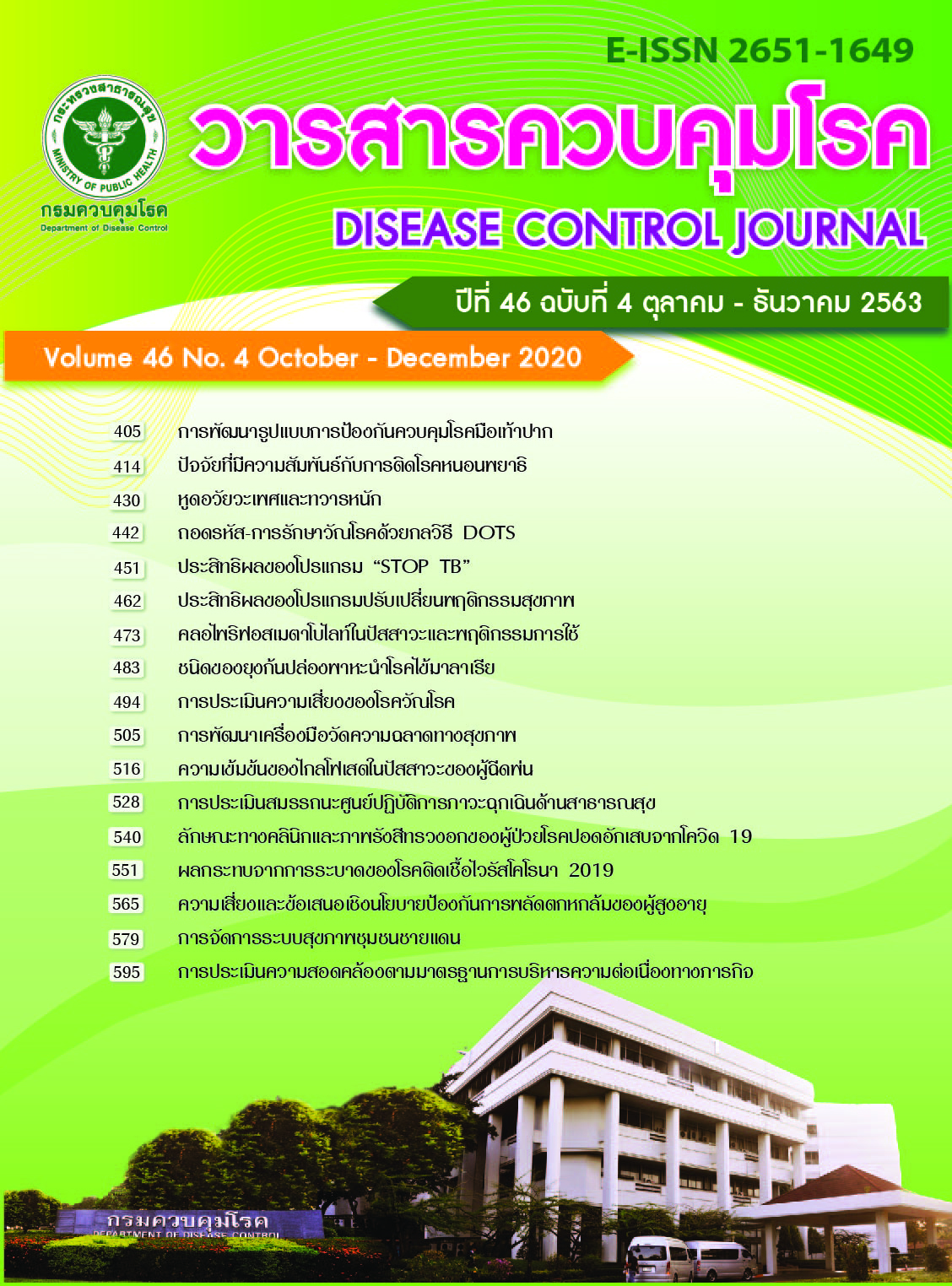Urinary glyphosate concentration of sprayers in Nakhon Sawan Province, Thailand
DOI:
https://doi.org/10.14456/dcj.2020.48Keywords:
Glyphosate, urine, sprayers, HPLC-FLDAbstract
Glyphosate is extensively used to control grasses and broadleaf weeds in agricultural field. This study aimed to measure urinary glyphosate concentrations in 49 sprayers. We interviewed the subjects and collected urine samples for 3 time periods; the first morning void urine the day before spraying, urine at the end of spraying task, and the first morning void urine the next day after spraying. The urine samples were analyzed with high pressure liquid chromatography with fluorescence detector. The results found that the geometric mean of urinary glyphosate concentrations at the end of spraying event and the next day after spraying were significantly different from those at the day before spraying (Repeated measure ANOVA, p<0.001 and p<0.001, respectively). The highest urinary glyphosate concentrations in the next day after spraying had a geometric mean (geometric standard deviation) of 49.49 (2.63) µg/g creatinine. This study indicated that the urinary glyphosate concentrations of the sprayers were higher than those in the other studies. The sprayers should therefore be provided with appropriate trainings on how to safely use and handle the chemical and registered as glyphosate sprayers for monitoring purposes; they should also be allowed to buy glyphosate in the amount that is consistent with the size of their agricultural areas that need spraying. Sprayers should wear proper personal protective equipment, including mask, gloves and shoes. In addition, they should also have proper behaviors and practices, for instance, properly washing hands before eating or drinking, changing contaminated clothing and taking a shower immediately in order to reduce health risk of the sprayers.
Downloads
References
Tarazona JV, Court-Marques D, Tiramani M, Reich H, Pfeil R, Istace F, et al. Glyphosate toxicity and carcinogenicity: a review of the scientific basis of the European Union assessment and its differences with IARC. Arch Toxicol. 2017;91(8):2723–43.
Benbrook CM. Trends in glyphosate herbicide use in the United States and globally. Environ Sci Eur. 2016;28(1):3.
World Health Organization. IARC Monographs volume 112: evaluation of five organophosphate insecticides and herbicides. Geneva: World Health Organization; 2015.
Bradberry SM, Proudfoot AT, Vale JA. Glyphosate poisoning. Toxicol Rev. 2004;23(3):159–67.
Thai-PAN (Thailand Pesticide Alert Network). Summary of hazardous pesticides in year 2017 [Internet]. 2018 [cited 2020 May 6]. 33 p. Available from: https://www.thaipan.org/wp-content/uploads/2018/10/pesticide_doc54.pdf
National Health Security Office. NHSO support the banning of the three pesticides. [Internet]. 2015 [cited 2020 May 6]. 1 p. Available from: https://www.nhso.go.th/FrontEnd/NewsInformationDetail.aspx?newsid=MjM5OQ==
Koller VJ, Furhacker M, Nersesyan A, Misik M, Eisenbauer M, Knasmueller S. Cytotoxic and DNA-damaging properties of glyphosate and Roundup in human-derived buccal epithelial cells. Arch Toxicol. 2012;86(5):805-13.
Acquavella JF, Alexander BH, Mandel JS, Gustin C, Baker B, Chapman P, et al. Glyphosate biomonitoring for farmers and their families: results from the Farm Family Exposure Study. Environ Health Perspect. 2004;112(3):321-6.
Kongtip P. Nangkongnab N, Mahaboonpeeti R, Bootsikeaw S, Batsungnoen K, Hanchenlaksh C, et al. Differences among Thai agricultural worker health, working conditions and pesticide use by farm type. Ann Work Expo Health. 2018;62(2):167-81.
Bernal J, Bernal JL, Martin MT, Nozal MJ, Anadon A, Martínez-Larrañaga MR, et al. Development and validation of a liquid chromatography–fluorescence–mass spectrometry method to measure glyphosate and aminomethylphosphonic acid in rat plasma. Journal of Chromatography B 2010;878(31):3290-6.
Polyiem W, Hongsibsong S, Chantara S, Kerdnoi T, Patarasiri V, Prapamonto T, et al. Determination and assessment of glyphosate exposure among farmers from northern part of Thailand. Journal of Pharmacology and Toxicology. 2017;12(2):97-102.
Connolly A, Jones K, Galea KS, Basinas I, Kenny L, McGowan P, et al. Exposure assessment using human biomonitoring for glyphosate and fluroxypyr users in amenity horticulture. Int J Hyg Environ Health. 2017;220(6):1064-73.
Connolly A, Basinas I, Jones K, Galea K, Kenny L, McGowan P, et al. Characterising glyphosate exposures among amenity horticulturists using multiple spot urine samples. Int J Hyg Environ Health. 2018;221(17):1012-22.
Connolly A, Jones K, Basinas I, Galea KS, Kenny L, McGowan P, et al. Exploring the half-life of glyphosate in human urine samples. Int J Hyg Environ Health. 2019;222(2):205-10.
Curwin BD, Hein MJ, Sanderson WT, Striley C, Heederik D, Kromhout H, et al. Urinary pesticide concentrations among children, mothers and fathers living in farm and non-farm households in Iowa. Ann Occup Hyg 2007;51(1):53-65.
Downloads
Published
How to Cite
Issue
Section
License
Articles published in the Disease Control Journal are considered as academic work, research or analysis of the personal opinion of the authors, not the opinion of the Thailand Department of Disease Control or editorial team. The authors must be responsible for their articles.






